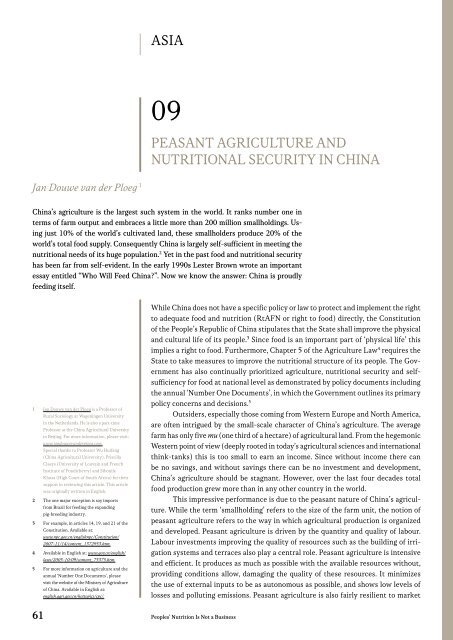RIGHT TO FOOD AND NUTRITION WATCH
1iNBHTY
1iNBHTY
Create successful ePaper yourself
Turn your PDF publications into a flip-book with our unique Google optimized e-Paper software.
ASIA<br />
09<br />
PEASANT AGRICULTURE <strong>AND</strong><br />
<strong>NUTRITION</strong>AL SECURITY IN CHINA<br />
Jan Douwe van der Ploeg 1<br />
China’s agriculture is the largest such system in the world. It ranks number one in<br />
terms of farm output and embraces a little more than 200 million smallholdings. Using<br />
just 10% of the world’s cultivated land, these smallholders produce 20% of the<br />
world’s total food supply. Consequently China is largely self-sufficient in meeting the<br />
nutritional needs of its huge population. 2 Yet in the past food and nutritional security<br />
has been far from self-evident. In the early 1990s Lester Brown wrote an important<br />
essay entitled “Who Will Feed China?”. Now we know the answer: China is proudly<br />
feeding itself.<br />
1 Jan Douwe van der Ploeg is a Professor of<br />
Rural Sociology at Wageningen University<br />
in the Netherlands. He is also a part-time<br />
Professor at the China Agricultural University<br />
in Beijing. For more information, please visit:<br />
www.jandouwevanderploeg.com.<br />
Special thanks to Professor Wu Huifang<br />
(China Agricultural University), Priscilla<br />
Claeys (University of Louvain and French<br />
Institute of Pondicherry) and Sibonile<br />
Khoza (High Court of South Africa) for their<br />
support in reviewing this article. This article<br />
was originally written in English.<br />
2 The one major exception is soy imports<br />
from Brazil for feeding the expanding<br />
pig-breeding industry.<br />
3 For example, in articles 14, 19, and 21 of the<br />
Constitution. Available at:<br />
www.npc.gov.cn/englishnpc/Constitution/<br />
2007-11/14/content_1372953.htm.<br />
4 Available in English at: www.gov.cn/english/<br />
laws/2005-10/09/content_75375.htm.<br />
5 For more information on agriculture and the<br />
annual ‘Number One Documents’, please<br />
visit the website of the Ministry of Agriculture<br />
of China. Available in English at:<br />
english.agri.gov.cn/hottopics/cpc/.<br />
61<br />
While China does not have a specific policy or law to protect and implement the right<br />
to adequate food and nutrition (RtAFN or right to food) directly, the Constitution<br />
of the People’s Republic of China stipulates that the State shall improve the physical<br />
and cultural life of its people. 3 Since food is an important part of ‘physical life’ this<br />
implies a right to food. Furthermore, Chapter 5 of the Agriculture Law 4 requires the<br />
State to take measures to improve the nutritional structure of its people. The Government<br />
has also continually prioritized agriculture, nutritional security and selfsufficiency<br />
for food at national level as demonstrated by policy documents including<br />
the annual ‘Number One Documents’, in which the Government outlines its primary<br />
policy concerns and decisions. 5<br />
Outsiders, especially those coming from Western Europe and North America,<br />
are often intrigued by the small-scale character of China’s agriculture. The average<br />
farm has only five mu (one third of a hectare) of agricultural land. From the hegemonic<br />
Western point of view (deeply rooted in today’s agricultural sciences and international<br />
think-tanks) this is too small to earn an income. Since without income there can<br />
be no savings, and without savings there can be no investment and development,<br />
China’s agriculture should be stagnant. However, over the last four decades total<br />
food production grew more than in any other country in the world.<br />
This impressive performance is due to the peasant nature of China’s agriculture.<br />
While the term ‘smallholding’ refers to the size of the farm unit, the notion of<br />
peasant agriculture refers to the way in which agricultural production is organized<br />
and developed. Peasant agriculture is driven by the quantity and quality of labour.<br />
Labour investments improving the quality of resources such as the building of irrigation<br />
systems and terraces also play a central role. Peasant agriculture is intensive<br />
and efficient. It produces as much as possible with the available resources without,<br />
providing conditions allow, damaging the quality of these resources. It minimizes<br />
the use of external inputs to be as autonomous as possible, and shows low levels of<br />
losses and polluting emissions. Peasant agriculture is also fairly resilient to market<br />
Peoples’ Nutrition Is Not a Business


